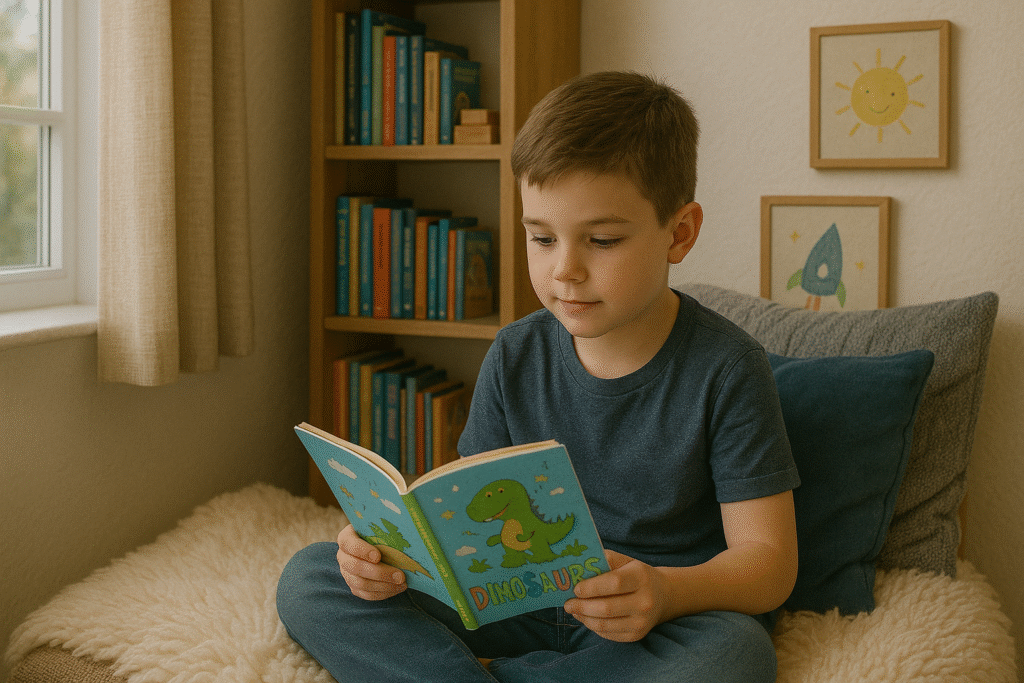Mental Health Awareness Week is a valuable time to reflect on the importance of emotional well-being, especially for children. Reading is a powerful tool that can support young minds, helping them process emotions, develop empathy, and build resilience. Through mindful reading activities, storytelling, and family engagement, books can provide comfort, understanding, and a sense of calm.
Here’s how you can use reading to support children’s mental health during Mental Health Awareness Week.

Creating a calm reading environment
Why a peaceful space matters
A comfortable, distraction-free reading space can help children relax and fully immerse themselves in stories. A calm reading environment can:
- Reduce stress and anxiety by providing a quiet retreat.
- Encourage focus and mindfulness through undisturbed reading.
- Promote a positive association with books and storytelling.
Setting up a cozy reading space
- Choose a quiet area: Select a peaceful corner in the home where children can read without interruptions.
- Use soft lighting: Gentle lighting, such as fairy lights or a small reading lamp, creates a calming atmosphere.
- Provide comfortable seating: Cushions, bean bags, or a cozy blanket can make reading more inviting.
- Encourage personalisation: Let children decorate their reading nook with their favourite books and comforting items.

Incorporating mindful reading activities
Reading as a mindfulness practice
Mindfulness and reading go hand in hand, as both encourage focus and present-moment awareness. Here are ways to make reading a mindful activity:
- Deep breathing before reading: Take a few deep breaths before starting a book to create a sense of calm.
- Engage with the senses: Encourage children to notice the details in illustrations, feel the texture of pages, and listen to the rhythm of words.
- Read slowly and thoughtfully: Instead of rushing through, take time to pause, reflect, and absorb the story.
Storytelling and listening as mindfulness exercises
- Guided storytelling: Read aloud and encourage children to visualize scenes in their minds.
- Listening to audiobooks: Calming stories can serve as a soothing bedtime routine.
- Journaling about books: Encourage children to write or draw their thoughts about the stories they read.
Encouraging emotional resilience through reading
Discussing emotions in books
Reading provides opportunities to explore feelings and emotions in a safe and structured way. Discussing characters’ emotions can help children understand their own experiences.
- Ask open-ended questions like, “How do you think the character felt?”
- Discuss how different characters handle challenges and conflicts.
- Encourage children to relate book themes to their own experiences.
Choosing books that build empathy and understanding
Books that explore themes of kindness, resilience, and friendship can support a child’s emotional growth.
- Select books with diverse characters and perspectives to foster empathy.
- Read stories about overcoming fears, perseverance, and self-confidence.
- Choose books with comforting messages about emotions and mental well-being.
Family bonding over storytelling
The benefits of shared reading
Reading together strengthens family bonds and creates moments of connection.
- Sharing stories allows children to express thoughts and feelings in a safe space.
- Reading aloud provides comfort and reassurance.
- Storytelling as a family builds trust and deepens relationships.
Ways to make family storytelling engaging
- Take turns reading aloud as a family.
- Encourage children to create and share their own stories.
- Use storytelling prompts to spark creativity.
Role of consistent reading during school breaks
Reading is a beneficial activity for children’s mental well-being, especially during school breaks.
- Provides stability: Keeping a reading routine helps maintain a sense of normalcy.
- Offers an emotional outlet: Books can serve as a comforting escape from daily worries.
- Encourages reflection: Thought-provoking stories help children process emotions.
How Reading Chest can support mental well-being
Access to a variety of books can help children explore different emotions and experiences. Reading Chest offers:
- Books tailored to reading levels: Helping children engage at the right pace.
- Flexible subscriptions: A steady supply of diverse reading materials.
- Resources for parents to support reading and emotional well-being.
Incorporating reading into Mental Health Awareness Week can provide children with comfort, understanding, and emotional resilience. Whether through mindful reading, engaging storytelling, or family bonding, books offer a safe and enriching way to explore emotions.
Looking for book recommendations? Learn more about Reading Chest and how it can support your child’s reading journey.
How are you using books to support children’s mental health? Share your experiences with us on Twitter/X, Facebook, and Instagram. Let’s promote well-being through reading together!
